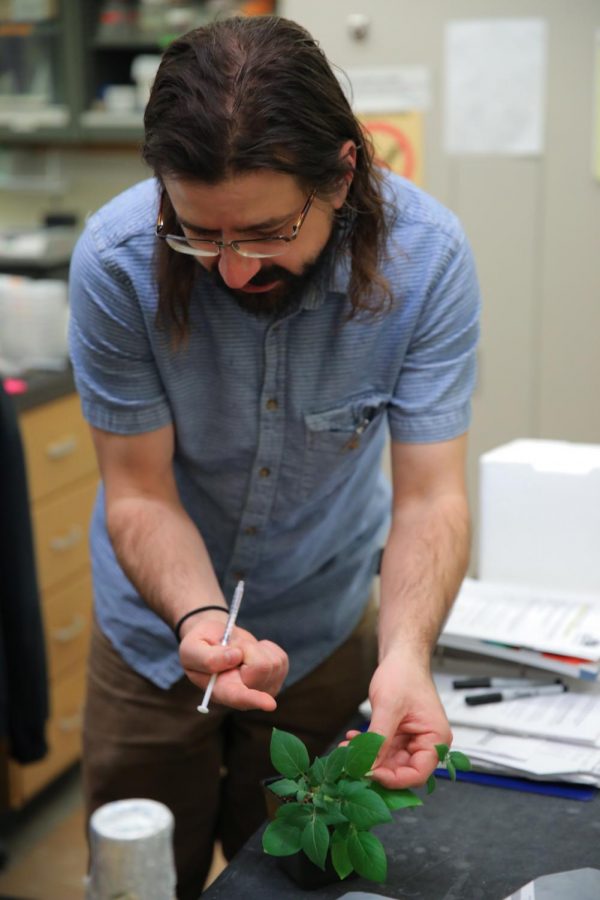Researchers advance in plant breeding efforts
Knowing how plants defend against damage can yield breeding benefits
BENJAMIN MICHAELIS | THE DAILY EVERGREEN
Jeremy Jewell, a postdoctoral research associate, injects a solution into the leaf of a potato plant to study how it reacts to the solution Wednesday in Johnson Hall.
January 18, 2019
Researchers from the WSU Department of Plant Pathology recently pinpointed the gene pathways responsible for immune systems in plants.
This research can have implications for breeding plants that are more resistant to pests and pathogens, said Kiwamu Tanaka, an assistant professor and principal investigator in the study.
Tanaka said adenosine triphosphate (ATP), an energy molecule that is crucial for cell function, is primarily found inside of cells. When ATP is found outside a cell, it can signal damage caused by a pathogen or another enemy of the plant.
“A cell contains all the ATP,” he said, “and just like an ATP bomb, if you cut it, the ATP will spread into the surrounding of the cell. Then other cells will try to respond.”
He said ATP outside the cell acts as a damage-associated molecular pattern (DAMP), a biomolecule that helps cells recognize if there is damage that needs an immune response.
“The first alert system is ATP,” Tanaka said.
Once ATP binds to receptors on other cells, a number of pathways are activated through phosphorylation, he said. By binding to these other cells, ATP starts a chain reaction. This causes the expression of several defensive genes.
In humans, the expression of defense genes might result in swelling or heat at the wound site, Tanaka said.
Plants, on the other hand, make their nutrients indigestible by producing chemicals to harm pathogens or prevent feeding, said Jeremy Jewell, a postdoctoral research associate. This response varies between plants.
“[Plants] make a lot of poisons,” Jewell said. “Secondary metabolites are stuff the plant makes to deter feeding or growth of a pathogen.”
Tanaka said by using several varieties of mouse-ear cress, a type of plant with a relatively small number of genes, researchers were able to isolate the pathways responsible for the defense response.
Jewell said there are multiple pathways responsible for defensive immune response. Tanaka said there are approximately 500 genes that result in the expression of immune responses in plants.
One called the putative-ATP pathway is believed to be triggered specifically when extracellular ATP is detected. This creates an immune response that occurs even in mutant plants that do not have a typical defense, he said.
Tanaka said knowing how plants defend against damage can lead to better breeding. Plant varieties with certain genes will be able to defend themselves quicker once an invader is detected.
He said plants with strong immune responses will be more resistant to pests and other damage-causing organisms. These responses will breed more successful crops.
Tanaka said plants that are resistant to certain pathogens will be able to grow more effectively because of a pattern called the defense-growth trade-off.
Similar to how the human body invests energy in an immune response to combat illness, resulting in tiredness, plants that are defending against pathogens cannot grow effectively, he said.
“If you turn the defense system on, then plant growth stops,” Tanaka said. “If you enhance plant growth, then the immune system goes down.”
He said this research focuses on a specific field that studies how DNA is transcribed and subsequently expressed in a variety of organisms called transcriptomics.
“Human body [immune research] is already happening,” Tanaka said. “That research is very up front right now. Plant research has just started.”






















